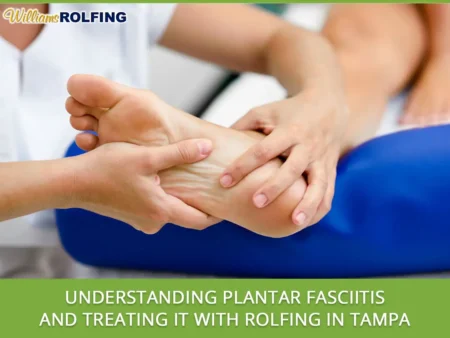November 4, 2025

Many residents of Tampa struggle with heel pain that disrupts daily activities, exercise routines, and overall comfort.
Plantar fasciitis, which is an inflammation of the thick band of tissue that connects the heel bone to the toes, is one of the most common causes. While traditional approaches, such as stretching, rest, or orthotics, can offer relief, Rolfing provides a more comprehensive and holistic approach to the lasting treatment of plantar fasciitis.
This method focuses on improving body alignment, muscle balance, and connective tissue health, helping individuals reduce pain and restore natural movement.
What Is Plantar Fasciitis?
Plantar fasciitis happens when the plantar fascia, a strong band of connective tissue that runs along the bottom of the foot, gets irritated or strained. This tissue holds up the arch and absorbs shock with each step. When it is stressed repeatedly, tiny tears can form, leading to inflammation and pain.
A sharp pain in the heel or sole is a common symptom, especially when you first get up in the morning or after standing for a long time. If you don’t treat the pain, it can spread through the foot over time and change how you walk, stand, and move. People who stand for extended periods, wear shoes that don’t support their feet, or engage in activities that place excessive stress on their feet are more likely to develop this condition.
How Rolfing Supports Healing
Rolfing, also known as Structural Integration, is a type of manual therapy that focuses on the fascia, the connective tissues in the body. Rolfing differs from regular massage in that it focuses on realigning and balancing the body’s overall structure, rather than just targeting specific muscles. Stress and imbalance often lead to conditions like plantar fasciitis, which Rolfing effectively treats.
A Rolfing practitioner puts slow, precise pressure on the fascia around the feet, calves, and legs to help them relax. Rolfing helps to realign the feet and relieve stress on the plantar fascia by loosening tight areas in areas. Many clients report that their foot pain gradually subsides and their flexibility improves as their posture and weight distribution improve.
Rolfing also helps you gain a deeper understanding of how your body works. Practitioners frequently instruct clients in movement patterns that enhance healthier habits for standing, walking, and running. This combination of structural and functional improvements helps prevent plantar fasciitis from recurring and makes it easier to move around in general.
Comparison with Conventional Treatments
Common treatments for plantar fasciitis include rest, ice, stretching exercises, and the use of orthotic supports. These may help alleviate symptoms, but they may not address the underlying issues that cause the condition. Rolfing examines the entire body because it recognizes that tightness in the calves, hamstrings, or hips can alter how the foot distributes weight.
Rolfing treats the body as a whole system, providing a long-term solution rather than just treating symptoms. It works well with medical treatments and physical therapy, and choosing the right shoes can help you stay balanced and move more efficiently. This method allows many people in Tampa to feel better, stand up straighter, and feel more in sync with their bodies.
Benefits of Rolfing for Plantar Fasciitis
Rolfing can help individuals experiencing pain in their heels and arches in various ways. It allows the fascia to become longer and softer, which gives the plantar tissue time to heal after being overused. Hands-on techniques that improve circulation help speed up the healing process and reduce inflammation. After regular sessions, many clients say that their whole lower body, including their ankles, knees, hips, and back, feels more in line.
Rolfing also helps people become more aware of movement patterns that might be causing pain. Many clients discover that they have habits such as leaning forward when walking or favoring one side of their body. Fixing these patterns helps spread pressure evenly across the feet and legs, which reduces the likelihood of pain returning.
Frequently Asked Questions
How many Rolfing sessions are needed for plantar fasciitis?
Results vary, but many clients begin to see improvements after a few sessions. A typical Rolfing series consists of ten sessions that work on the entire body in a planned manner.
Is Rolfing painful?
Rolfing can be a little uncomfortable during deeper work, but the practitioners change the pressure to fit each person’s level of comfort. Most clients say that the experience was more relieving than painful.
Can Rolfing replace medical treatment?
Rolfing is not a replacement for medical care, but it can be used with physical therapy, orthotics, or other professional care. It focuses on restoring the body’s structure to balance, thereby aiding the healing process.
Does Rolfing help with other conditions?
Yes. Rolfing can help alleviate various issues, including back pain, shoulder tension, and poor posture. It helps with flexibility and awareness of your entire body.
Who can benefit from Rolfing in Tampa?
Anyone experiencing long-term pain, difficulty moving, or tight muscles can benefit. It is beneficial for athletes, office workers, and individuals recovering from an injury.
For those in Tampa seeking an effective, natural treatment for plantar fasciitis, Rolfing offers a comprehensive solution that focuses on structural alignment and long-term comfort. By addressing the deeper causes of tension and imbalance, this approach not only relieves pain but also improves posture and movement. For professional Rolfing sessions designed to restore balance and promote recovery, contact Williams Rolfing to schedule a consultation today.
Picture Credit: Freepik
